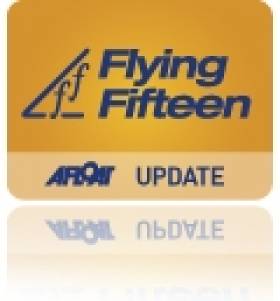Displaying items by tag: Phil Evans
Flying Fifteen Champions Defend European Title, Top Irish Seventh
#flyingfifteen – Hayling Island Sailing Club's Greg Wells and Richard Riggs, from the UK, successfully defended their Flying Fifteen European keelboat title in a cliffhanger finish at Port de Pollenca in Northern, Mallorca last Friday. In a dominant display, British boats took the top six places overall. A seven boat Irish team from Dublin Bay made the trip to the Balearic venue. The top Irish result came from John Lavery and David O'Brien of the National Yacht Club in seventh. Full results below.
Wells described the closing moments as 'a miracle run & beat' to recover from tenth at the first mark of the last race of the light air nine race series to cross the line in third. It was just enough on tie break to put former world champions Steve Goacher and Phil Evans, who led throughout the final race, into second overall.
Flying 15 - 2014 European Championship, Final positions
1 GBR 4030 Greg Wells, Richard Rigg 6 1 2 3 1 1 2 1 3 20 14 pts
2 GBR 4021 Steve Goacher, Phil Evans 1 2 1 2 2 2 3 8 1 22 14 pts
3 GBR 4005 David McKee, Andy Weatherspoon 3 3 3 1 13 10 4 2 10 49 36 pts
4 GBR 3998 Alan Bax, Mark Darling 2 6 8 4 8 RAF 1 6 2 69 37 pts
5 GBR 4019 David Tabb, Chewey Sherrell 4 4 7 9 4 4 6 7 5 50 41 pts
6 GBR 3957 Charles Apthorp, Gavin Tappenaen 7 8 4 5 5 8 9 3 4 53 44 pts
7 IRL 4002 John Lavery, David o brien 16 5 5 13 3 7 8 5 8 70 54 pts
8 GBR 4016 Hamish Mackay Andrew, Lawson 12 15 11 7 7 14 7 9 7 89 74 pts
9 IRL 3864 Ian Mathews, Keith Poole 10 13 6 8 6 6 21 18 11 99 78 pts
10 GBR 4025 Chris Gorringe, Nadia Hosie 5 7 9 15 15 17 10 4 21 103 82 pts
11 GBR 4020 Graham Scroggie, Ben Scroggie 9 18 10 12 9 11 5 26 14 114 88 pts
12 ESP 3279 Juan G. Manresa, Luis Valentin Fernández 13 12 18 25 14 3 13 15 9 122 97 pts
13 GBR 3914 Adrian Tattersall, Tim Smart 8 11 OCS 11 17 15 14 12 17 137 105 pts
14 GBR 4029 Stephen Hopson, Nigel King 15 9 13 18 16 9 16 10 18 124 106 pts
15 ESP 3804 David Michael, Clough Alan Green 17 19 14 6 12 13 17 17 12 127 108 pts
16 ESP 3592 Vicent Harris, Patrick Harris 18 16 12 20 20 21 12 11 6 136 115 pts
17 ESP 3728 David James Barber, Hannah Elizabeth Barber 14 17 19 22 10 20 11 16 29 158 129 pts
18 ESP 3577 John Lawrence Walker, Stephen Babbage 22 14 20 17 24 12 22 14 19 164 140 pts
19 IRL 3938 Niall Meagher, Nicki Matthews 11 21 17 21 28 23 15 20 13 169 141 pts
20 IRL 3757 Tom Galvin, Ben Mulligan 20 10 OCS 14 11 24 23 21 28 183 151 pts
21 ESP 3724 Staphen John Hart, Steven Phillips 27 20 22 16 18 18 30 23 16 190 160 pts
22 IRL 4028 Dave Mulvin, Valerie Mulvin 28 30 27 26 26 5 28 13 15 198 168 pts
23 IRL 3897 Ken Dumpleton, John Mcneilly 21 23 16 23 19 22 24 DNF 25 205 173 pts
24 GBR 3610 David Miles, Philip Marcus Parry 30 26 25 10 25 16 26 22 24 204 174 pts
25 IRL 3893 Peter Lawson, Jo 19 22 15 27 22 DNF 18 DNF 23 210 178 pts
26 IRL 3774 Tom Murphy, Hugh Cahill 23 28 21 30 21 28 19 24 26 220 190 pts
27 ESP 3763 Scott Walker, Andrew Harvey 26 25 24 24 27 25 20 27 20 218 191 pts
28 ESP 3589 Emiliano Llinás, Rafael Jaime Matas 25 27 28 28 30 27 27 19 22 233 203 pts
29 ESP 3600 Michael Beecken, Stephen Parry 24 31 26 29 23 19 29 28 30 239 208 pts
30 IRL 3665 Ryan Ryan, John Macaree DNC 24 29 DNF 29 26 25 25 27 249 217 pts
31 ESP 3388 Francisco Palmer, Jaume Pujadas 29 29 23 19 DNF DNC DNC DNC DNC 260 228 pts





























































